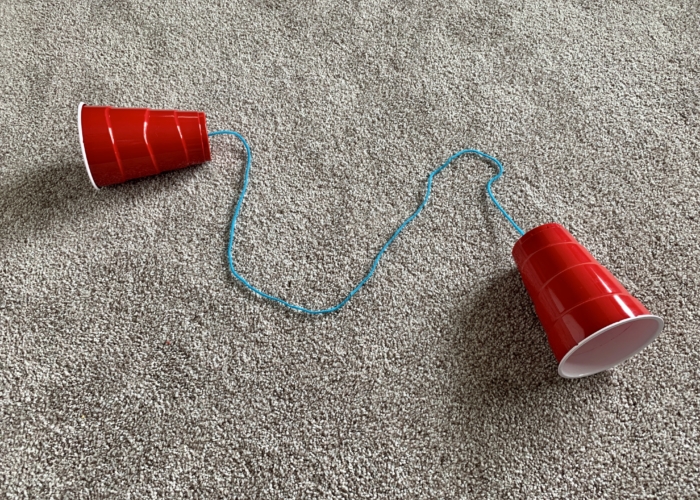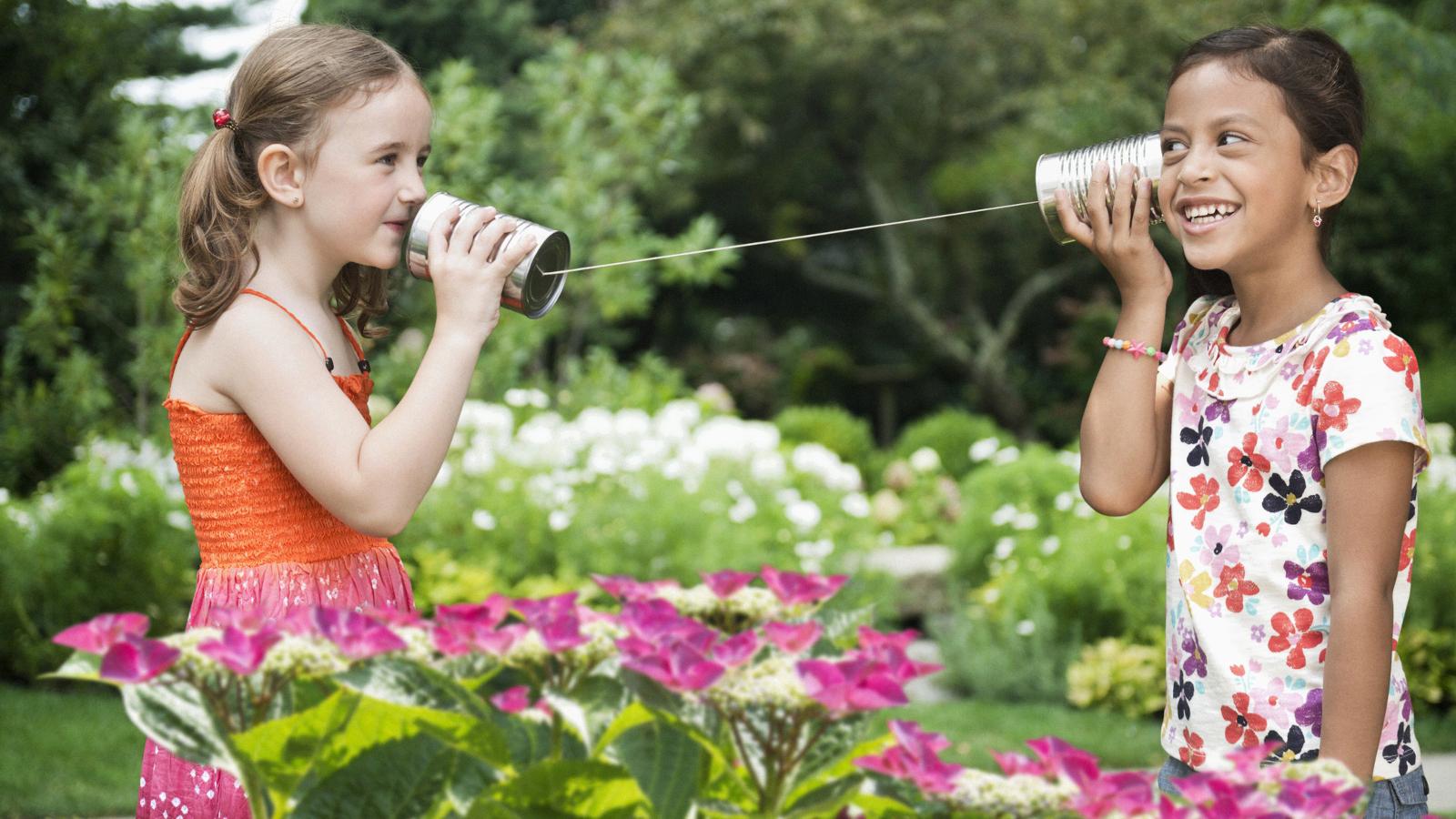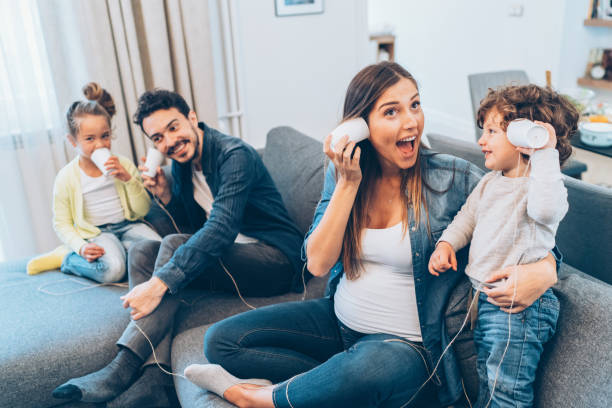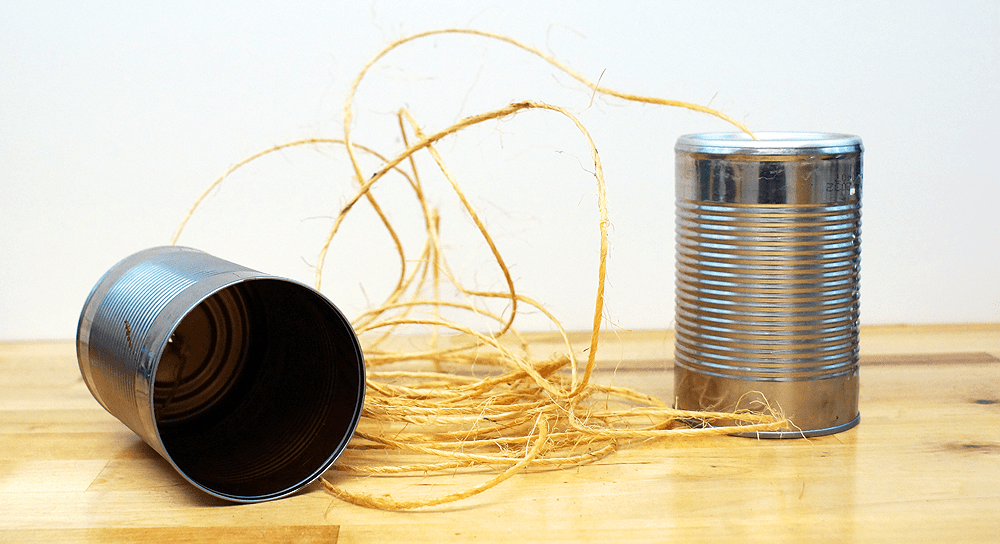Cup phones are a classic childhood toy that have been around for generations. They may seem like a simple and primitive way to communicate, but have you ever wondered how they actually work? In this blog post, we’ll explore the science behind cup phones and explain why they are able to transmit sound over distances.
First, let’s take a closer look at what a cup phone actually is. It’s essentially a makeshift telephone made out of two cups (usually paper or plastic) connected by a piece of string. The cups act as the receivers and the string serves as the transmitter. When one person speaks into one cup, the sound waves travel down the string and into the other cup, allowing the other person to hear what was said.
So how does this work scientifically? It all comes down to the principles of sound waves and vibrations. When a person speaks into the cup, teir voice creates sound waves that travel through the air and vibrate the bottom of the cup. These vibrations are then transferred down the string and into the other cup, where they cause the bottom of that cup to vibrate as well. These vibrations are then translated back into sound waves and heard by the person on the other end.
But why does the string need to be present? Why can’t the sound waves just travel through the air from one cup to the other? The answer lies in the fact that sound waves lose energy as they travel through the air, making them weaker and harder to hear over distances. The string, however, acts as a conductor, allowing the sound waves to travel much more efficiently over long distances.
Of course, there are limitations to the range of cup phones. The maximum distance they can transmit sound depends on a variety of factors, including the length and thickness of the string, the material and size of the cups, and the ambient noise level in the environment. In general, cup phones are only effective for distances of up to 100 feet or so, but this can vary depending on the specific setup.
Cup phones may seem like a simple and outdated form of communication, but they actually rely on some pretty complex scientific principles to work. By understanding how sound waves and vibrations are transferred through the cups and string, we can appreciate the ingenuity behind this classic childhood toy. So next time you’re feeling nostalgic, grab a couple of cups and some string and try making your own cup phone to see just how well it works!
How Far Can Cup Phones Reach?
Cup phones, also known as string telephones, are a simple and fun way to communicate with soeone over a distance. The range of the cup phone depends on a few factors, such as the length and tautness of the string, the size and shape of the cups, and the clarity of the sound being transmitted. Generally, cup phones can work over distances of up to 100 feet or more, depending on these factors. However, it’s important to note that cup phones are not as reliable or effective as other forms of communication, such as telephones or walkie-talkies. They are best used for fun and informal communication, rather than for important or urgent messages.

Can Plastic Cups Be Used with Cup Phones?
Yes, cup phones can work with plastic cups. The basic principle behind the cup phone communication is the transmission of sound waves through a taut string or wire between two cups. The material of the cups does not affect the sound transmission, as long as the cups are sturdy enough to hold the string taut. However, it’s worth noting that the thickness and quality of the material of the cups can affect the clarity of the sound. Therefore, it’s best to use cups that are relatively thin and have a smooth surface for beter sound transmission. Overall, whether you use plastic or paper cups, the cup phone experiment can be a fun way to explore the science of sound and communication.
The Best String for Cup Phones
When it comes to making cup phones, the best type of string to use is cotton twine. Cotton twine is strong enough to hold the cups together, and the cotton fibers alow for the vibrations created by speaking into the cups to travel through the string and into the other cup more effectively than other types of string. Additionally, cotton twine is not too thick or too thin, which helps to ensure that the cups stay securely attached and that the string doesn’t cut into the cups or slip out of the holes. So, if you’re planning on making cup phones, be sure to choose a high-quality cotton twine for the best results.
The Range of a String Telephone
A string telephone, also knon as a tin can telephone or a cup and string telephone, is a simple device that consists of two tin cans or cups connected with a taut string or wire. Initially, the maximum range of such a device was very limited, and the sound quality was poor. However, over time, technical innovations and improvements have been made, resulting in about 300 patents. As a result, the range of a string telephone has increased to approximately 0.5 miles (800 m), or more under ideal conditions. It is important to note, though, that the range of a string telephone can be affected by various factors such as the thickness and length of the string, the quality of the cups, and the environment in which it is used.
Does Placing a Phone in a Glass Cup Increase Its Volume?
When you put your phone in a glass cup, it can make the sound slightly louder. This hppens because the sound waves produced by your phone bounce off the walls of the cup and get directed up and outwards. This amplifies the sound waves and makes them more audible. However, it’s important to note that the increase in volume may not be significant, and it may also depend on the size and shape of the cup. Additionally, it’s important to ensure that the cup is clean and dry to avoid any liquids getting on your phone. Overall, while putting your phone in a glass cup can make the sound slightly louder, it may not be a significant increase and should be used with caution to avoid any damage to your phone.

Source: science.howstuffworks.com
Using Yarn for Cup Phones
Yes, you can use yarn for cup phones. Yarn is a good alternative to string because it is strong enough to transmit sound vibrations and can easily fit through the small holes made in the bottom of the paper cups. However, it is important to note that the thickness and quality of the yarn may affect the clarity of the sound transmitted through the cup phones. So, it is recommended to use a high-quality yarn that is not too thick or too thin for optimal results.
Can a Cup Be Used as a Speaker?
Yes, a cup can work as a speaker. It is a simple DIY project that involves cutting two holes into the sides of two plastic drinking cups and inserting a toilet paper or paper towel tube. The sound produced is surprisingly good and your phone or music player can be plced upright in the cups. However, for better sound quality, it is recommended to cut holes into the bottoms of the cups as well. This allows for better air circulation and enhances the sound. While it may not be as powerful as a professional speaker, it is a fun and inexpensive way to amplify sound.
The Advantages of Plastic Phones Over Glass Phones
When it comes to the durability of a phone, plastic can be considered a better option than glass. Plastic is known to be tough and resistant to shattering, scratches, and dents, which makes it a durable material to build phones out of. On the other hand, glass is prone to cracking and shattering if dropped, making it less durable than plastic.
Additionally, plastic’s slight flexibility allows it to absorb shock better than glass, making it more resistant to cracks and dents. This is particularly important for those who tend to drop their phones frequently.
However, when it comes to the oerall appearance and aesthetic appeal of a phone, glass is often favored due to its sleek and modern look. Glass can also provide better clarity for the display, which is important for those who use their phones for multimedia purposes.
Ultimately, the choice between a plastic or glass phone comes down to personal preference and priorities. If durability and resistance to damage are top priorities, then a plastic phone may be a better choice. But if appearance and display clarity are more important, then a glass phone may be the way to go.
Can Cups and String be Used for Communication?
Yes, cups and string actually work as a means of communication. The sound waves produced by a person’s voice cause the string to vibrate, which then travels along the string and is picked up by the other person’s cup. When the other person speaks, their voice causes the string in their cup to vibrate, which travels along the string and is picked up by the frst person’s cup.
However, the success of this method of communication depends on the quality of the cups and string used, as well as the distance between the two cups. The string should be tight and taut, and the cups should be held firmly against the ears to minimize sound loss. Additionally, the distance between the two cups should be limited to ensure that the sound waves do not dissipate before reaching the other person’s cup.
Overall, while cups and string may seem like a primitive method of communication compared to modern technology, they can still be a fun and effective way to communicate over short distances.

Ideal Length of Cup Phone Strings
The length of cup phone strings can vary depending on the desired distance between the cups. However, a good starting point is to use a length of string that is about 25 feet long. This length allows for a decent distance between the cups while still maintaining good sound quality. It’s important to make sure that the string is long enogh to reach from one cup to the other, but not so long that it becomes difficult to handle or tangles easily. Ultimately, the ideal length of cup phone strings will depend on personal preference and the specific situation in which they are being used.
The Effects of Pinching a Cup Phone String
When you pinch the string of a cup phone, you obstruct the flow of sound waves that travel thrugh the string. This results in a decrease in the amplitude of the sound waves, which means that the volume of the sound will reduce considerably. As a result, your friend on the other end of the cup phone will not be able to hear your voice as clearly as before. Pinching the string also alters the frequency of the sound waves, making the voice sound distorted and unclear. Therefore, it is important to ensure that the string of the cup phone remains free from any obstructions to maintain clear communication.
The Future of Landline Phones
Landline phones have been a staple of communication for over a century. However, with the advent of new technologies, the use of traditional copper-wire landlines has been declining in recent years. In fact, the FCC Landline Shutdown Order 19-72 has mandated that copper-wire landlines be phased out starting on August 2nd, 2022. This means that traditional landline service providers will no longer offer their services, and customers will be forced to transition to internet-based phone service. Therefore, it is safe to say that the use of traditional landline phones will come to an end in the near future. However, it is important to note that there are still many households and businesses that rely on landline phones, and they will liely continue to use them until they are no longer supported by their service providers.
The Length of the Longest Tin Can Phone
The longest functioning tin can telephone ever recorded measures an impressive 242.62 meters (or 796 feet). This achievement was made possible through the collaboration of three companies: Puzz Lab Inc., SUSUMU Inc., and Gakken Plus Co. A tin can telephone is a simple communication device made of two tin cans or cups connected by a taut string or wire. Sound waves are transmitted through the wire, allowing people to communicate with each other over a distance. The record-breaking tin can phone demonstrates the potential of this simple technology to transmit sound over incredible distances.

What is the Name of the Can String Phone?
The can string phone is commonly known as a tin can telephone or a paper cup telephone. It is a simple communication device made by connecting two tin cans or paper cups with a string. When one person speaks into one of the cans or cups, the sound vibrations travel through the string and are picked up by the other person on the other end. This classic children’s toy has been around for many years and is a fun and educational way to explore the principles of sound and communication.
Conclusion
In conclusion, cup phones do indeed work and have been used as a fun and simple means of communication for many years. While their maximum range may be limited, technical innovations have improved their range to approximately 0.5 miles or more under ideal conditions. By usng just a few common materials such as cups, string, and scissors, anyone can create a cup phone and enjoy communicating over short distances. So next time you’re out camping or just looking for a fun DIY project, give the cup phone a try and experience the magic of communication through a simple yet effective device.
